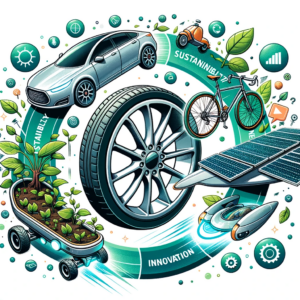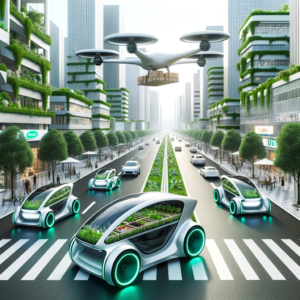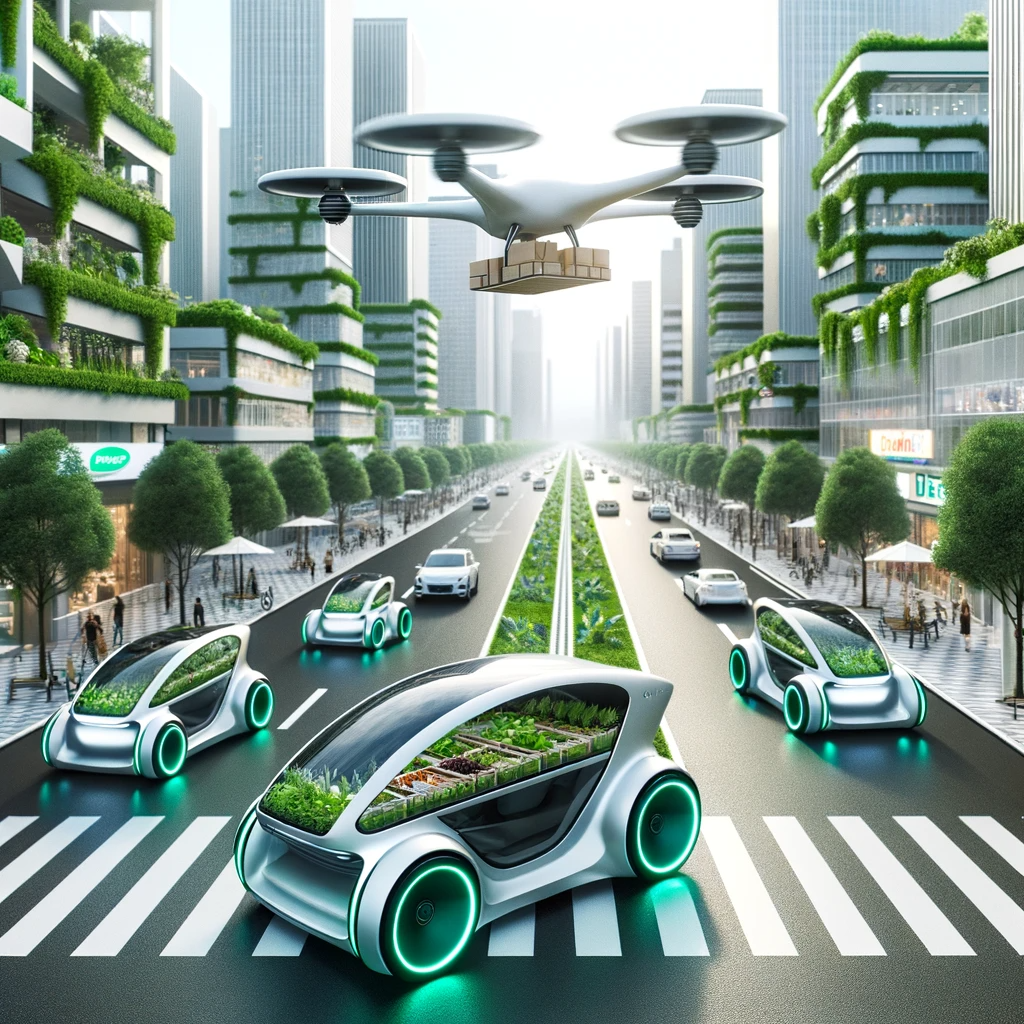Imagine a world where transportation is truly sustainable, where vehicles don’t harm the environment and contribute to global warming. This is not just a dream, but a vision that is steadily becoming a reality. In this article, we will explore the exciting advancements in eco-friendly transportation technologies and how they are reinventing the wheel. From electric cars to hydrogen-powered vehicles, brace yourself for a glimpse into a future where mobility and environmental consciousness go hand in hand. Prepare to be amazed by the innovative solutions that are shaping the future of transportation.
The Urgent Need for Eco-Friendly Transportation Technologies
In today’s world, the need for eco-friendly transportation technologies has become more urgent than ever before. The current transportation systems heavily rely on fossil fuels, which contribute to environmental degradation and climate change. The emissions from vehicles and airplanes are major contributors to air pollution, greenhouse gas emissions, and global warming. Therefore, it is crucial to shift towards cleaner and more sustainable alternatives to protect our planet.
Current Environmental Impact of Transportation
Transportation, as it is currently structured, has a significant negative impact on the environment. The burning of fossil fuels in cars, trucks, and airplanes releases carbon dioxide and other greenhouse gases into the atmosphere, contributing to the increase in global temperatures. This leads to climate change, resulting in extreme weather events, rising sea levels, and the loss of biodiversity.
Moreover, transportation is a major source of air pollution, with vehicles emitting harmful pollutants such as nitrogen oxides, particulate matter, and volatile organic compounds. These pollutants have detrimental effects on human health, causing respiratory diseases and cardiovascular problems. Additionally, the noise pollution generated by high traffic volumes affects the well-being and quality of life of individuals living in urban areas.

Role of Transportation in Climate Change
Transportation plays a pivotal role in climate change due to its heavy reliance on fossil fuels. The burning of gasoline and diesel fuels releases carbon dioxide, a greenhouse gas, into the atmosphere, contributing significantly to global warming. The transportation sector accounts for a substantial portion of global greenhouse gas emissions, making it a critical sector to address in efforts to mitigate climate change.
Furthermore, transportation-related emissions contribute to the formation of ground-level ozone, a harmful air pollutant known for its negative impact on human health and the environment. The emissions, combined with other external factors such as temperature inversions, exacerbate the accumulation of harmful pollutants, leading to smog and poor air quality in urban areas.
Global Commitment to Reduce Carbon Emissions
Recognizing the urgency to reduce carbon emissions and mitigate the impacts of climate change, countries around the world have made commitments to transition to greener transportation technologies. The Paris Agreement, an international treaty adopted in 2015, aims to limit global warming to well below 2 degrees Celsius above pre-industrial levels. To achieve this, countries have pledged to decrease their carbon emissions, including those from the transportation sector.
The commitment to reduce carbon emissions has driven countries to adopt renewable energy sources and promote the transition from fossil fuel-powered vehicles to more sustainable alternatives. Governments are implementing policies and offering incentives to promote the adoption of electric vehicles and the use of renewable energy in transportation. This global commitment sets the stage for the future of eco-friendly transportation technologies.

Shift from Fossil Fuel to Electric Vehicles
History and Evolution of Electric Vehicles
Electric vehicles (EVs) have a long history, dating back to the 19th century. However, it was not until recent decades that technological advancements and environmental concerns led to the resurgence of electric vehicles as a viable alternative to traditional gasoline-powered cars. The development of battery technology and improvements in charging infrastructure have contributed to the increased adoption of EVs.
Current Market Scenario for Electric Vehicles
The market for electric vehicles has been steadily growing, with many countries setting ambitious targets for the adoption of EVs. Electric cars are becoming more affordable, and governments are offering incentives such as tax breaks and subsidies to encourage their purchase. Additionally, the expansion of charging infrastructure is addressing the issue of range anxiety, making electric vehicles a viable option for everyday transportation.
The Future of Electric Vehicles
The future of electric vehicles looks promising, with continual advancements in battery technology, charging infrastructure, and vehicle design. As battery costs decrease and energy densities increase, the range and performance of electric vehicles will improve. Furthermore, the integration of renewable energy sources into the charging infrastructure will enhance the sustainability of electric vehicles. The future of transportation is electric, and the shift towards electric vehicles is crucial for a sustainable future.
Methods of Reducing Carbon Footprint in Aviation
Emerging Trends Towards Fuel Efficiency in Air Travel
The aviation industry has been actively pursuing measures to improve fuel efficiency and reduce carbon emissions. Airlines are investing in modernizing their fleets with fuel-efficient aircraft that consume less fuel per passenger or cargo unit. The use of lightweight materials in aircraft construction, more efficient engines, and optimized flight routes are all contributing to increased fuel efficiency in air travel.
Implementation of New Technologies in the Aviation Industry
Advancements in technology, such as the use of Sustainable aviation fuels, have the potential to significantly reduce the carbon footprint of the aviation industry. Sustainable aviation fuels, often derived from renewable sources, can be blended with conventional jet fuel to reduce the emissions from aircraft. Furthermore, the development of electric and hybrid aircraft offers promising alternatives to traditional jet engines.
Role of Biofuel in Aviation
Biofuels have emerged as a viable solution for reducing carbon emissions in aviation. They can be produced from renewable feedstocks such as algae, crop residues, and waste oils. Biofuels have the advantage of being drop-in replacements for conventional jet fuel, requiring minimal modifications to aircraft and infrastructure. The use of biofuels in aviation can significantly reduce the sector’s carbon footprint and contribute to a more sustainable future.

Innovations in Public Transportation
Eco-friendly Buses and Trains
Public transportation plays a crucial role in reducing carbon emissions by providing an alternative to individual car use. Eco-friendly buses and trains are being developed with a focus on energy efficiency and reduced emissions. Electric buses, for example, offer a cleaner and quieter mode of transportation, minimizing the environmental impact of public transit systems. Additionally, trains powered by renewable energy sources further contribute to the goal of sustainable public transportation.
The Promise of Hyperloop Technology
Hyperloop technology presents an innovative and environmentally-friendly mode of transportation. Hyperloop systems use magnetic levitation and low-pressure environments to transport passengers or cargo at high speeds. This technology has the potential to revolutionize transportation by offering a sustainable alternative to air travel and long-distance car journeys. Hyperloop systems can be powered by renewable energy sources, further reducing their carbon footprint.
Reducing Carbon Emissions Through Shared Mobility
Shared mobility services, such as carpooling and ride-sharing, have gained popularity as a means to reduce the number of vehicles on the road and decrease carbon emissions. By maximizing the occupancy of vehicles and minimizing the distance traveled, shared mobility can significantly reduce the environmental impact of transportation. Additionally, the integration of electric vehicles into shared mobility services further enhances their sustainability.
Eco-Friendly Maritime Transportation Technologies
Impact of Shipping on the Environment
Shipping is a vital component of global trade, but it also has a significant environmental impact. Large cargo ships emit significant amounts of greenhouse gases, contributing to climate change. Additionally, the discharge of ballast water, the release of pollutants, and the potential for oil spills are all environmental concerns associated with maritime transportation.
Current Energy Saving Measures in Maritime Transportation
To address the environmental impact of shipping, the industry has implemented various energy-saving measures. These include the use of more fuel-efficient engines, optimizing ship design for improved aerodynamics, and adopting slow-speed navigation to reduce fuel consumption. Additionally, the use of alternative fuels and the integration of renewable energy sources, such as wind and solar power, are being explored to further reduce the carbon footprint of maritime transportation.
The Future of Green Shipping
The future of green shipping lies in the development of alternative fuels, such as hydrogen and ammonia, that have the potential to replace traditional bunker fuels. Additionally, advancements in ship design, including the use of innovative materials and hull coatings, can improve fuel efficiency and reduce emissions. Furthermore, the integration of autonomous and electric-powered vessels can revolutionize the maritime transportation industry, making it more sustainable and environmentally friendly.

Role of Cycling and Pedestrianization in Urban Areas
Impact of Cycling and Walking on Carbon Emissions
Promoting cycling and pedestrianization in urban areas can significantly reduce carbon emissions. By encouraging individuals to choose active modes of transportation over cars, cities can alleviate traffic congestion and decrease air pollution. Cycling and walking produce zero emissions and have the added benefits of promoting physical activity and improving public health.
Policies and Infrastructure for Encouraging Cycling and Pedestrianization
Cities can adopt various policies and infrastructure solutions to encourage cycling and pedestrianization. Implementing dedicated cycling lanes, improving sidewalks, and installing bike-sharing programs are effective ways to facilitate active modes of transportation. Additionally, introducing traffic calming measures, such as reducing speed limits and creating pedestrian-friendly zones, can enhance the safety and attractiveness of walking and cycling in urban areas.
Case Studies of Successful Cycling Cities
Cities around the world have successfully implemented cycling-friendly initiatives, leading to increased cycling rates and reduced carbon emissions. Copenhagen, Denmark, is often cited as a model cycling city, with an extensive network of bike lanes and a culture that prioritizes cycling as a mode of transportation. Similarly, cities like Amsterdam, Netherlands, and Portland, Oregon, in the United States, have invested in infrastructure and policies to promote cycling, resulting in a significant shift towards sustainable urban transportation.
Integration of Artificial Intelligence in Transportation
Role of AI in Optimizing Traffic Flow
Artificial intelligence (AI) plays a vital role in optimizing traffic flow and reducing congestion. AI-powered intelligent transportation systems can collect and analyze real-time data to optimize traffic signal timings, dynamically adjust routes, and predict traffic patterns. By managing traffic more efficiently, AI can reduce travel times, fuel consumption, and carbon emissions associated with congestion.
AI in Vehicle Design and Manufacture
AI is increasingly being integrated into vehicle design and manufacturing processes. It allows for the optimization of vehicle components and structures, leading to lighter and more energy-efficient vehicles. Additionally, AI can improve production efficiencies, reduce waste, and enhance the overall sustainability of the automotive industry.
Prospects of AI in Public Transportation
AI holds great potential in improving the efficiency and sustainability of public transportation systems. Intelligent routing algorithms can optimize bus and train schedules, reducing empty trips and minimizing fuel consumption. AI-powered predictive maintenance can also help prevent breakdowns and optimize maintenance schedules, resulting in more reliable and energy-efficient public transportation services.

Harnessing Solar Power in Transportation
Current Use of Solar Power in Transportation
Solar power is being harnessed in transportation to reduce reliance on fossil fuels. Solar panels can be integrated into vehicles, providing an additional source of power for onboard systems. Solar-powered charging stations are also being deployed, enabling electric vehicles to charge using renewable energy. Furthermore, solar-powered boats and ships are being developed, offering a sustainable alternative for maritime transportation.
Advancements in Solar-Powered Vehicles
Advancements in solar-powered vehicles are making them more practical and efficient. The integration of lightweight, high-efficiency solar panels onto the surfaces of cars, buses, and even bicycles can generate electricity to supplement the vehicle’s power needs. Additionally, advancements in energy storage systems, such as improved batteries and supercapacitors, enable solar-powered vehicles to store and utilize solar energy more effectively.
Future Prospects of Solar Energy in Transportation
The future prospects of solar energy in transportation are promising. As solar technology continues to advance, solar-powered vehicles may become more commonplace, offering a sustainable and renewable form of transportation. Furthermore, the integration of solar power into charging infrastructure and the development of solar highways could revolutionize the way we power our vehicles, reducing our dependence on non-renewable energy sources.
Eco-Friendly Innovations in Freight and Logistics
Carbon Footprint of Freight Transportation
Freight transportation is a significant contributor to carbon emissions due to the high energy requirements of moving goods over long distances. Trucks and ships, in particular, produce substantial amounts of carbon dioxide. Addressing the carbon footprint of freight transportation is crucial for achieving a more sustainable transportation system.
Technological Solutions for Reducing Emissions in Logistics
Technological solutions, such as route optimization algorithms and advanced logistics management systems, can reduce emissions in the freight and logistics sector. Optimizing delivery routes and consolidating shipments can minimize the distance traveled and maximize fuel efficiency. Additionally, the use of alternative fuels, such as liquefied natural gas or electric-powered trucks, offers greener alternatives for transporting goods.
Future of Green Logistics
The future of green logistics lies in the adoption of sustainable practices throughout the supply chain. This includes the use of renewable energy sources to power warehouses and distribution centers, implementing efficient packaging and waste management systems, and promoting the adoption of environmentally friendly transportation modes. Green logistics initiatives can reduce the carbon footprint of freight transportation and contribute to the overall sustainability of the global supply chain.
Challenges and Opportunities in Eco-Friendly Transportation
Issues Facing Implementation of Eco-Friendly Technologies
The implementation of eco-friendly transportation technologies faces several challenges. The high upfront costs associated with transitioning to cleaner alternatives, such as electric vehicles or renewable energy systems, can be a barrier for widespread adoption. Additionally, the lack of charging infrastructure, limited range of electric vehicles, and resistance from established industries can hinder the advancement of eco-friendly technologies.
Financial and Political Support for Eco-Technologies
Despite the challenges, there are significant opportunities for financial and political support for eco-technologies in transportation. Governments and organizations are increasingly recognizing the importance of sustainable transportation and are investing in research and development, infrastructure improvements, and incentives to promote the adoption of eco-friendly technologies. The transition to cleaner transportation systems can create job opportunities and stimulate economic growth.
Anticipated Breakthroughs in Eco-Friendly Transportation
The future of eco-friendly transportation holds the potential for exciting breakthroughs. Advancements in battery technology, such as solid-state batteries with higher energy densities, could revolutionize electric vehicles. Furthermore, the development of hydrogen fuel cells, more efficient renewable energy systems, and the integration of smart grid technologies are anticipated breakthroughs that could enhance the sustainability of transportation.
In conclusion, the urgent need for eco-friendly transportation technologies is evident in the current environmental impact of transportation and its role in climate change. The shift from fossil fuel to electric vehicles, innovations in public transportation, the harnessing of solar power, and the adoption of sustainable practices in freight and logistics are key areas that can contribute to reducing carbon emissions. However, challenges and opportunities must be addressed to ensure the successful implementation of eco-friendly technologies. The future of transportation lies in our commitment to sustainable and environmentally responsible solutions. By reinventing our transportation systems, we can create a cleaner, greener, and more sustainable future for generations to come.










